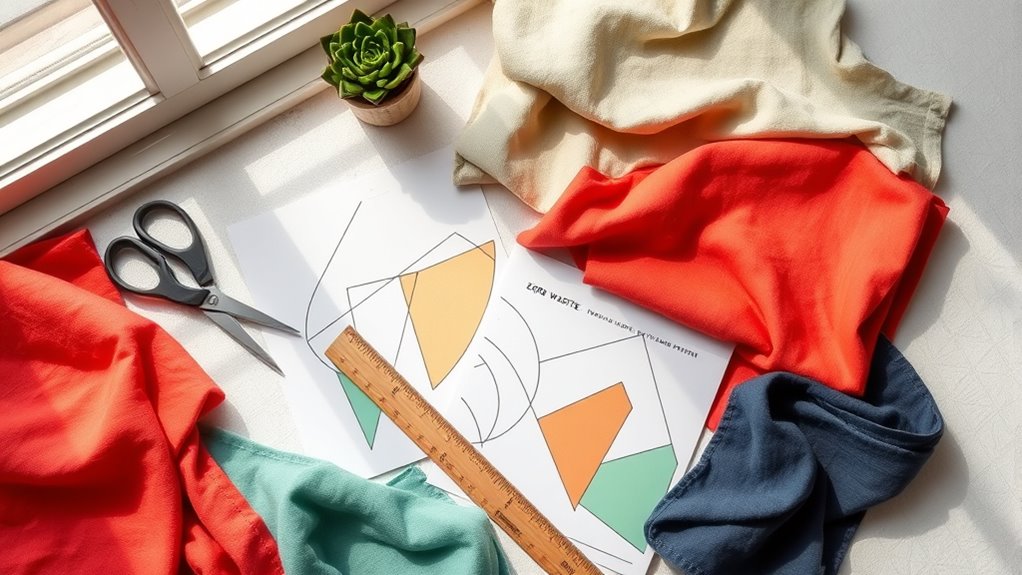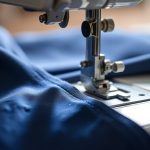Zero waste sewing patterns help you create stylish garments while minimizing fabric waste. By using innovative techniques and thoughtful design, you can transform scraps into functional pieces and contribute to a healthier planet. These patterns not only encourage creativity but also allow you to adapt them to various sizes and styles. Plus, sourcing sustainable materials enhances your eco-friendly projects. You’ll soon discover tips and communities dedicated to zero waste practices that can inspire your sewing journey.
Understanding Zero Waste Sewing
When you plunge into the world of zero waste sewing, you’ll discover a mindful approach that challenges traditional garment-making practices. Embracing zero waste principles means you’re not just sewing garments; you’re creating with intention, reducing material waste to nearly nothing.
By mastering pattern drafting techniques, you can design pieces that utilize every inch of fabric, transforming what would typically be scraps into usable components. This method encourages creativity, pushing you to think outside the box while ensuring that your creations are both stylish and sustainable. As you explore zero waste sewing, you’ll find joy in the process, knowing that each stitch contributes to a healthier planet. It’s about crafting thoughtfully and making a positive impact with every project.
The Environmental Impact of Fabric Waste
Did you know that the fashion industry contributes considerably to fabric waste, with millions of tons ending up in landfills each year? This staggering statistic highlights the urgent need for more sustainable practices in sewing and fashion. Fortunately, there are eco-friendly alternatives available that not only reduce waste but also promote a more mindful approach to your creative projects.
Fabric Waste Statistics
Every year, the fashion industry generates an estimated 92 million tons of waste, much of which comes from fabric scraps and unsold garments. This staggering amount of fabric waste contributes greatly to environmental issues. To put it in perspective, consider these statistics:
- Approximately 15% of fabric is wasted during the manufacturing process.
- The production of synthetic fibers creates microplastics that pollute oceans.
- Landfills receive over 11 million tons of textile waste annually.
- The fashion industry is responsible for 10% of global carbon emissions.
- Only 1% of discarded clothing is recycled into new garments.
Understanding these environmental statistics can inspire you to make more conscious choices, ultimately reducing your contribution to fabric waste. Embrace the zero waste movement for a healthier planet!
Sustainable Alternatives Available
A growing number of sustainable alternatives are now available to help combat the environmental impact of fabric waste. You can choose from organic cotton, hemp, and Tencel, which are not only made from sustainable materials but also produced through ethical manufacturing processes. These fabrics require fewer resources and chemicals, reducing your ecological footprint.
Additionally, consider upcycling or repurposing fabric scraps; it’s a creative way to minimize waste while crafting unique pieces. Brands that prioritize transparency and sustainability are also emerging, offering patterns and kits designed for zero waste. By opting for these alternatives, you’re making a positive impact, supporting a circular economy, and contributing to a healthier planet. Every small choice counts, so let’s sew sustainably!
Benefits of Zero Waste Sewing Patterns
While traditional sewing often results in leftover fabric scraps, zero waste sewing patterns offer a sustainable alternative that maximizes material use. By embracing design innovation, you not only create beautiful garments but also contribute to waste reduction. Here are some benefits you’ll enjoy:
- Eco-friendly: Reduce your environmental footprint by minimizing fabric waste.
- Cost-effective: Use every inch of fabric, saving money in the long run.
- Creative challenge: Engage your sewing skills with unique designs that require innovative thinking.
- Versatility: Many patterns can be adapted for various sizes and styles.
- Community impact: Join a movement of like-minded individuals committed to sustainability.
With zero waste patterns, you’re making a positive impact while enjoying the art of sewing.
Popular Zero Waste Sewing Patterns to Try
If you’re looking to elevate your sewing game while embracing sustainability, exploring popular zero waste sewing patterns is a fantastic choice. These innovative designs not only reduce fabric waste but also offer incredible garment versatility. For instance, the “Woven Tee” pattern allows you to transform leftover fabric into stylish tops, while the “Wrap Skirt” cleverly utilizes every inch of material.
The “Kimono Jacket” is another favorite, perfect for layering and adapting to various seasons. Plus, these patterns inspire creativity, encouraging you to experiment with colors and textures without guilt. By choosing zero waste patterns, you’re contributing to a more sustainable fashion future while enjoying the satisfaction of making unique pieces that reflect your individual style.
Techniques for Zero Waste Sewing
When it comes to zero waste sewing, understanding various techniques can make a significant difference in reducing fabric scraps. Utilizing effective pattern drafting and smart fabric layout strategies can lead to more sustainable projects. Here are some key techniques you might consider:
- Modular Designs: Create pieces that can mix and match, maximizing fabric usage.
- Creative Cutting: Use unconventional shapes and angles to minimize leftover fabric.
- Reversible Patterns: Design items that can be worn inside out, guaranteeing both sides are utilized.
- Patchwork Techniques: Combine smaller scraps into beautiful, unique designs.
- Efficient Layout: Plan your pattern layout meticulously to guarantee every inch of fabric counts.
Tips for Planning Your Zero Waste Projects
As you begin your zero waste sewing projects, careful planning is essential to guarantee every inch of fabric is put to good use. Effective project planning and resource management can make a significant difference. Start by visualizing your design and sketching out a pattern layout to maximize fabric usage. Consider using remnants for smaller projects, like accessories or patches.
| Tips | Benefits |
|---|---|
| Sketch your design | Optimizes fabric layout |
| Use remnants | Reduces waste |
| Plan for versatility | Maximizes resource efficiency |
This approach not only minimizes waste but also encourages creativity. Remember, every small effort contributes to a sustainable future, so plan wisely!
Sourcing Sustainable Fabrics
When you’re sourcing sustainable fabrics, consider eco-friendly options that minimize environmental impact. Think about supporting local artisans by choosing materials that are sourced nearby, or get creative with upcycled fabrics to give new life to old textiles. Each choice you make can help reduce waste and promote a more sustainable sewing practice.
Eco-Friendly Fabric Options
Choosing eco-friendly fabrics is essential for anyone looking to create sustainable sewing projects. By opting for these materials, you’re making a positive impact on the planet. Here are some great options to evaluate:
- Organic cotton: Grown without harmful pesticides, it’s gentle on the environment.
- Recycled polyester: Made from post-consumer plastic, it helps reduce waste.
- Hemp blends: Durable and biodegradable, hemp requires little water to grow.
- Bamboo textiles: Naturally antimicrobial, bamboo is a renewable resource.
- Tencel fabric: Produced from sustainably sourced wood, it’s soft and biodegradable.
Don’t forget to use eco-friendly dyes and biodegradable threads to complete your sustainable projects. Choosing these fabrics not only benefits the earth but also enhances your sewing experience.
Locally Sourced Materials
Sourcing locally can considerably reduce your carbon footprint and support your community, making it an essential step in sustainable sewing. By shopping at local fabric markets, you not only find unique materials but also contribute to your area’s economy. Plus, these markets often feature eco-friendly options that align with your values.
Participating in community fabric swaps is another excellent way to source materials sustainably. You can exchange unused fabrics with fellow crafters, ensuring those textiles find new life instead of ending up in a landfill. This practice fosters creativity and keeps your sewing projects fresh and exciting while promoting a zero-waste mindset. Embrace these local resources to create beautiful pieces that reflect both your style and commitment to sustainability.
Upcycled Fabric Choices
While you might think new fabric is the only way to create stunning pieces, upcycled fabrics offer a fantastic alternative that’s both sustainable and unique. By choosing upcycled textiles, you’re not just diversifying your fabric stash; you’re also making an eco-conscious choice that supports sustainable sourcing. Here are some excellent options to contemplate:
- Vintage sheets and tablecloths for soft, unique patterns
- Old clothing that can be transformed into trendy pieces
- Remnants from local fabric stores, often available at a discount
- Upholstery scraps, perfect for durable items
- Fabric from thrift stores, where treasures await
Embracing upcycled fabrics allows you to express your creativity while reducing waste, making a positive impact on the environment.
Inspiring Zero Waste Sewing Communities
Many sewing enthusiasts are discovering the joy of zero waste practices, creating vibrant communities that inspire sustainable fashion. You’ll find that these communities come together through various community initiatives, emphasizing the importance of reducing textile waste. Participating in sewing workshops allows you to learn innovative techniques while connecting with like-minded individuals who share your passion for eco-friendly practices.
These gatherings often foster creativity and collaboration, encouraging everyone to share patterns and tips for maximizing fabric usage. By joining a zero waste sewing community, you not only enhance your skills but also contribute to a larger movement towards sustainability. So, immerse yourself in this inspiring world, and let your sewing projects reflect your commitment to the planet’s well-being.
How to Incorporate Zero Waste Practices in Everyday Sewing
How can you seamlessly integrate zero waste practices into your everyday sewing projects? It’s easier than you think! Start by being mindful of your fabric organization and use every scrap. Here are some practical tips to help you:
- Choose zero waste sewing patterns that minimize fabric waste.
- Store your scraps in labeled bins for easy access and inspiration.
- Use versatile sewing tools like rotary cutters to maximize efficiency and reduce waste.
- Repurpose small fabric pieces into accessories, patchwork, or quilts.
- Share leftover materials with fellow crafters or donate to local charities.
Frequently Asked Questions
Can I Modify Zero Waste Patterns for Different Sizes?
Absolutely, you can modify zero waste patterns for different sizes! Surprisingly, around 30% of fabric waste comes from improper sizing. By making size adjustments and pattern scaling, you’ll create less waste and achieve a perfect fit.
Are Zero Waste Patterns Suitable for Beginners?
Yes, zero waste patterns are beginner-friendly designs. They simplify the sewing process while maximizing fabric use, offering eco-conscious benefits. You’ll enjoy creating sustainable pieces without the stress of complicated techniques or wasteful practices.
Where Can I Find Zero Waste Sewing Workshops?
You can find local workshops at fabric stores or community centers. Online classes are also available through platforms like Skillshare and Udemy. Both options help you learn sustainable sewing techniques while connecting with like-minded individuals.
Do Zero Waste Patterns Require Special Sewing Techniques?
No, zero waste patterns don’t require special techniques, but you’ll need to focus on pattern layout for ideal fabric efficiency. Embracing these patterns enhances your sewing skills while promoting sustainability—making each creation more eco-friendly and resource-conscious.
How Do I Care for Garments Made From Zero Waste Patterns?
To care for your zero waste garments, use sustainable laundry practices like cold washes and air drying. These methods enhance garment longevity, ensuring they last longer while minimizing environmental impact. Embrace eco-friendly choices for lasting style!


